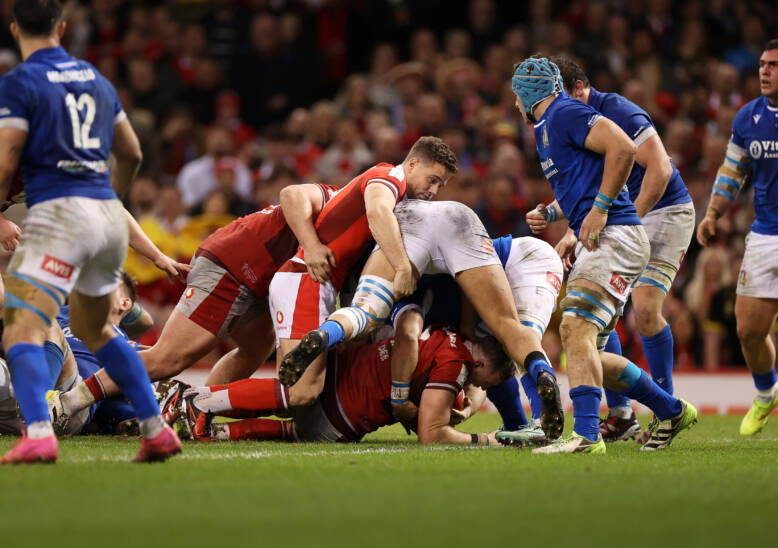World Rugby reveals phased plan to enhance rugby’s global appeal
- 3065

- Rugby united in drive to enhance entertainment value to broaden appeal
- World Rugby swiftly actioning key Shape of the Game forum outcomes
- Package of enhancements aimed at advancing on- and off-field experience
World Rugby has outlined the next steps in the process of reimagining rugby’s entertainment factor, part of a wider mission to grow audience share over the next decade.
Following agreement on an action plan at the Shape of the Game forum earlier this month to examine ways to advance the rugby experience in a changing sports and entertainment environment, World Rugby has set out a five-phase approach to explore, adopt and trial the key outcomes.
With decisions being made through the lens of player and fan experience as rugby seeks to grow relevance and accessibility among a broader, younger audience, evolution is focused on enhancing ball in flow, reducing stoppages and increasing welfare outcomes.
First phase: Law Application Guidelines reinforcing existing law
From 19 March, there will be an expectation of strict application of current law by referees globally via the following Law Application Guidelines, focusing on speeding up play:
- Law 15.17: Players will be expected to use the ball more quickly when the ball has been secured at a ruck/breakdown. Referees will be asked to call “use it” earlier, which will begin the five second count to play the ball away.
- Law 19.10: Hookers will be expected to maintain a full brake foot to aid scrum stability and safety during the engagement sequence. Any adjustment must maintain the act of the brake.
- Law 6.29: Strict reinforcement of the 2022 law trial relating to water carriers entering the field of play.
Second phase: Law amendment recommendations for global adoption
A package of law amendments will be considered by the World Rugby Council at its 9 May meeting. Each is aimed at enhancing game continuity:
- Recommendation to make adjustments to Law 10 in relation to players being put onside when there are kicks in open play, as per the current Super Rugby Pacific trial which aims to reduce kick tennis.
- Removal of the scrum option from a free-kick at a scrum, reducing dead time.
- Outlawing the practice of the ‘croc roll’, reinforcing player welfare focus
Third phase: Closed law trials
Unions and competition owners will be encouraged to implement a package of closed law trials which can be adopted at domestic or cross-border level, aimed at enhancing game continuity:
- Expansion of the shot clock for scrum and lineouts and reduced kicking time.
- Ability to mark the ball inside the 22m line from a restart, promoting attacking options.
- The ball must be played after the maul has been stopped once, not twice.
- Protection of the nine at the base of the scrum, ruck and at the maul following successful trials in Major League Rugby in the USA and in elite and community competitions in New Zealand.
- Play on for lineout not straight if the throw in is uncontested.
Fouth phase: Specialist working groups
Specialist working groups will be established to further explore aspects identified by the Shape of the Game forum for further consideration. Recommendations will be made to Council.
- On- and off-field sanctions: Comprehensive review of the sport’s disciplinary and sanctioning processes with the objective of streamlining, increasing simplicity, consistency and fan understanding. A key consideration will be the potential to combine stronger off-field sanctions for foul play with a global red card trial where a carded player is removed for the duration of the match but may be replaced by another player after 20 minutes. The final proposal will go to World Rugby’s Council in May.
- Tackle/Ruck/Breakdown: A major review of safety and spectacle issues as they relate to the breakdown, e.g. the impact of contesting the ball on the floor, jackal as opposed to an upright driving game.
- Television Match Official (TMO) protocol: Determine the optimal remit for the TMO protocol, while setting new minimum standards for technology providers.
- Replacements: Examine the latest research on the impact of fatigue and the number and timing of replacements in the elite game to determine options that might create more space on the field while improving injury rates.
- Fan experience: Build rugby’s attention share via a fan-focused view of how the game is marketed, a consistent approach to presentation of the sport across all media environments and a focus on the moments in the game that really engage fans. This will include a thorough review of the language and terminology that is used within the game.
- Tackle height: Consider the results of the community tackle height trials across 11 unions and consider appropriateness for elite rugby.
Fifth phase: Examine impact of specific aspects of the game in new Rugby Labs
New Rugby Labs, which enable World Rugby to test out new aspects of law in a controlled environment evaluated by data and player feedback, will be utilised to examine the impact of aspects of the game that either have an impact on speed or safety. These are likely to include the scrum engagement sequence and the tackle/ruck area.
Next steps
New Law Application Guidelines will come into effect from 19 March globally. The World Rugby Council will consider a package of Shape of the Game forum recommendations at its next meeting on 9 May. Some measures will take longer consideration and will be introduced in line with the defined moratorium windows for the men’s, women’s and sevens formats.
World Rugby Chairman Sir Bill Beaumont said: “Change is in rugby’s DNA. Two hundred years ago we were born from a desire to change, and we are harnessing that same spirit to excite the next generation of fans and players. The moves that we are making are grounded in our commitment to increasing relevance on a global basis and born from a desire to change for the better.
“That means being bold, embracing change by dialing up the entertainment value, making our stars more accessible and simplifying terminology and language used to explain rugby to those who are yet to fall in love with it.
“We have moved quickly. It has taken a special unity and commitment from across the sport to be able to present a package of enhancements to the Council in May. I look forward to the discussions.”
The plan was designed by the game for the game via the multi-stakeholder Shape of the Game forum featuring international competition and professional club competition representatives, coaches, International Rugby Players and International Rugby Match Officials representatives, union representatives, community game, laws, welfare and fan-engagement experts.











